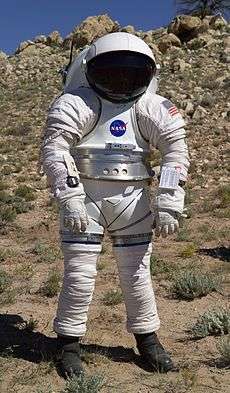Mark III (space suit)

The Mark III or MK III (H-1) is a NASA space suit technology demonstrator built by ILC Dover. While heavier than other suits (at 59 kilograms (130 lb), with a 15 kilograms (33 lb) Primary Life Support System backpack), the Mark III is more mobile, and is designed for a relatively high operating pressure.[1]
The Mark III is a rear-entry suit, unlike the EMU currently in use, which is a waist-entry suit. The suit incorporates a mix of hard and soft suit components, including hard upper torso, hard lower torso and hip elements made of graphite/epoxy composite, bearings at the shoulder, upper arm, hip, waist, and ankle, and soft fabric joints at the elbow, knee, and ankle.
The 8.3 pounds per square inch (57 kPa) operating pressure of the Mark III makes it a "zero-prebreathe" suit, meaning that astronauts would be able to transition directly from a one atmosphere, mixed-gas space station environment, such as that on the International Space Station, to the suit, without risk of the bends, which can occur with rapid depressurization from an atmosphere containing nitrogen or another inert gas. Currently, astronauts must spend several hours in a reduced pressure, pure oxygen environment before EVA to avoid these risks.[1]
Testing
The Mark III, as well as ILC's I-Suit, has been involved in field testing during NASA's annual Desert Research and Technology Studies (D-RATS) field trials, during which suit occupants interact with one another, and with rovers and other equipment.[2]
Subjects wearing the Mark III were able to kneel to pick up objects, a task which would be difficult in either the Apollo A7L or Shuttle EMU suit. Dean Eppler, a geologist at NASA's Johnson Space Center who wore the suit during testing, commented that "the Mark III in many cases has almost shirtsleeve-equivalent mobility."[3] Eppler has spent more than 100 hours in the Mark III.[2]
Despite the success of zero- and partial-gravity testing on the KC-135 Vomit Comet, the EVA Project Office at Johnson Space Center is currently looking toward a soft suit design for future astronauts.
References
- 1 2 Wade, Mark. "NASA Mark III". Encyclopedia Astronautica. Retrieved 2007-02-09.
- 1 2 "Weighing the Benefits of the I-suit". Astrobiology Magazine. October 20, 2005.
- ↑ "Learning to Work in the Suit". Astrobiology Magazine. October 10, 2005. Retrieved 2007-02-09.

